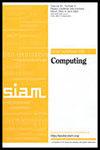修正主义模拟:证明空间下限的新方法
IF 1.6
3区 计算机科学
Q3 COMPUTER SCIENCE, THEORY & METHODS
引用次数: 0
摘要
SIAM 计算期刊》,第 53 卷第 4 期,第 1039-1084 页,2024 年 8 月。 摘要。确定解决无障碍(或随机无等待)[math]-set 协议所需的寄存器数量是一个开放性问题,它凸显了我们对同步空间复杂性理解的重要差距。在[math]进程中,解决这个问题所需的寄存器数量的已知上限是[math]寄存器。目前还不知道优于 2 的一般下限。我们证明,解决[math]进程间[math]集协议的任何无障碍协议都必须至少使用[math]个寄存器。特别是,我们得到了解决无阻碍和随机无等待共识的严格下限,即恰好使用 [math] 个寄存器。我们的主要工具是一种模拟,它是对确定性无等待[数学]集协议不可能性的还原。我们特别指出,如果[数学]集协议的无障碍协议使用的寄存器较少,那么[数学]进程就有可能模拟该协议,并以无等待的方式确定性地解决[数学]集协议,而这是不可能的。模拟的一个重要方面是模拟进程能够修改被模拟进程的过去。我们引入了一个增强的快照对象,为这一功能提供了便利。更广泛地说,我们的模拟适用于各种无色任务。例如,我们可以用它来证明解决无障碍[math]-近似一致问题所需的寄存器数量的下限,当[math]足够小时,它与已知的最佳上限相差不到 2 倍。目前还不知道这个问题的一般下限。最后,我们证明了无障碍协议使用的寄存器数量的任何下界都适用于满足非确定性独断性的协议。因此,我们对无阻塞协议的下界也适用于随机无等待协议。本文章由计算机程序翻译,如有差异,请以英文原文为准。
Revisionist Simulations: A New Approach to Proving Space Lower Bounds
SIAM Journal on Computing, Volume 53, Issue 4, Page 1039-1084, August 2024.
Abstract. Determining the number of registers required for solving obstruction-free (or randomized wait-free) [math]-set agreement is an open problem that highlights important gaps in our understanding of the space complexity of synchronization. The best known upper bound on the number of registers needed to solve this problem among [math] processes is [math] registers. No general lower bound better than 2 was known. We prove that any obstruction-free protocol solving [math]-set agreement among [math] processes must use at least [math] registers. In particular, we get a tight lower bound of exactly [math] registers for solving obstruction-free and randomized wait-free consensus. Our main tool is a simulation that serves as a reduction from the impossibility of deterministic wait-free [math]-set agreement. In particular, we show that if an obstruction-free protocol for [math]-set agreement uses fewer registers, then it is possible for [math] processes to simulate the protocol and deterministically solve [math]-set agreement in a wait-free manner, which is impossible. An important aspect of the simulation is the ability of simulating processes to revise the past of simulated processes. We introduce an augmented snapshot object, which facilitates this. More generally, our simulation applies to the broad class of colorless tasks. We can use it to prove, for example, a lower bound on the number of registers needed to solve obstruction-free [math]-approximate agreement, which matches the best known upper bound to within a factor of 2 when [math] is sufficiently small. No general lower bound for this problem was known. Finally, we prove that any lower bound on the number of registers used by obstruction-free protocols applies to protocols that satisfy nondeterministic solo-termination. Hence, our lower bounds for obstruction-free protocols also hold for randomized wait-free protocols.
Abstract. Determining the number of registers required for solving obstruction-free (or randomized wait-free) [math]-set agreement is an open problem that highlights important gaps in our understanding of the space complexity of synchronization. The best known upper bound on the number of registers needed to solve this problem among [math] processes is [math] registers. No general lower bound better than 2 was known. We prove that any obstruction-free protocol solving [math]-set agreement among [math] processes must use at least [math] registers. In particular, we get a tight lower bound of exactly [math] registers for solving obstruction-free and randomized wait-free consensus. Our main tool is a simulation that serves as a reduction from the impossibility of deterministic wait-free [math]-set agreement. In particular, we show that if an obstruction-free protocol for [math]-set agreement uses fewer registers, then it is possible for [math] processes to simulate the protocol and deterministically solve [math]-set agreement in a wait-free manner, which is impossible. An important aspect of the simulation is the ability of simulating processes to revise the past of simulated processes. We introduce an augmented snapshot object, which facilitates this. More generally, our simulation applies to the broad class of colorless tasks. We can use it to prove, for example, a lower bound on the number of registers needed to solve obstruction-free [math]-approximate agreement, which matches the best known upper bound to within a factor of 2 when [math] is sufficiently small. No general lower bound for this problem was known. Finally, we prove that any lower bound on the number of registers used by obstruction-free protocols applies to protocols that satisfy nondeterministic solo-termination. Hence, our lower bounds for obstruction-free protocols also hold for randomized wait-free protocols.
求助全文
通过发布文献求助,成功后即可免费获取论文全文。
去求助
来源期刊

SIAM Journal on Computing
工程技术-计算机:理论方法
CiteScore
4.60
自引率
0.00%
发文量
68
审稿时长
6-12 weeks
期刊介绍:
The SIAM Journal on Computing aims to provide coverage of the most significant work going on in the mathematical and formal aspects of computer science and nonnumerical computing. Submissions must be clearly written and make a significant technical contribution. Topics include but are not limited to analysis and design of algorithms, algorithmic game theory, data structures, computational complexity, computational algebra, computational aspects of combinatorics and graph theory, computational biology, computational geometry, computational robotics, the mathematical aspects of programming languages, artificial intelligence, computational learning, databases, information retrieval, cryptography, networks, distributed computing, parallel algorithms, and computer architecture.
 求助内容:
求助内容: 应助结果提醒方式:
应助结果提醒方式:


